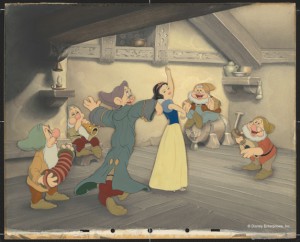
“Snow White Dancing with Dopey and Sneezy. Doc, Happy, Bashful, Sleepy Playing Music.” Disney Studio Artist Reproduction cel setup; ink and acrylic on cellulose acetate. Courtesy Walt Disney Animation Research Library. ©Disney.
The news is in: Snow White and The Seven Dwarfs: The Creation of a Classic is a hit. Here is a sampling of some of the recent press regarding our new exhibition:
“Exhibit looks at the work behind classic ‘Snow White'” Boston Globe, June 1, 2013
For diehard fans, the exhibition should seem positively enchanted. But even those with a simple fondness for illustration or curiosity about the collaborative process of big-studio animation will find a wealth of material to gorge on…
“The artists working behind animated films, whether it’s cels or today’s computer-generated 3-D, are impeccably trained illustrators and artists,” Norman Rockwell Museum director and CEO Laurie Norton Moffatt says. “We encourage people to think about the creative process that goes into the making of a film, or just a cover you might see on The New Yorker, and realize that an artist created that.”
“Norman Rockwell Museum to unveil new exhibit about Snow White’s inspiration,”Berkshire Eagle, June 2, 2013:
Among 200 young ladies in 1934 Marge Champion was the fairest of them all.
Walt Disney Pictures was looking for a young lady to inspire the movements of the titular character in the first feature-length animated film, “Snow White and the Seven Dwarfs.”
They found that inspiration in 14-year-old Champion, now 93, who has divided her time between the Berkshires and New York City since 1979.
“They needed to see how a young girl moved, and how her dress moved around her, especially when dancing with the dwarves,” Champion said during an interview at her Stockbridge home…
“I didn’t know what I was doing,” she said. “I was just doing an improvisation of whatever the animators showed me on the storyboards.”

“Snow White and Witch with Poisoned Apple,” Gustaf Tengrren. Book illustration; watercolor and ink on paper. Courtesy Walt Disney Family Foundation; ©Disney
“Snow White: The creation of a classic,” Berkshire Eagle, June 7, 2013:
“I think people will be surprised by the beautiful watercolors created to plot out angles, such as the scenes of the dwarfs chasing the witch up the mountain,” said Lella Smith, who, as creative director of the Walt Disney Company’s Animation Research Library, is the guest curator of the Rockwell exhibition. “They are like exquisite little paintings. The exhibit will enable people to see what a collaborative, work-intensive effort went into making this movie…”
The exhibition’s presence at the Rockwell museum is an extension of the long professional and personal relationship between Walt Disney and Norman Rockwell. A painting Rockwell gave to Disney inscribed to ” one of the really great artists, from an admirer, Norman Rockwell” was donated to the Rockwell Museum by Diane Disney Miller…
“Disney and Rockwell were both makers of pop icons, and both celebrated great art and shared their artistic visions with the world,” says Moffatt. “They weren’t competitors, they inspired each other, and they liked each other as well.”
“Rockwell Museum exhibit captures the magic of making ‘Snow White’,” Schenectady Gazette, June 8, 2013
“I want people to take away the feeling of the intense collaborative effort that was a part of every project of my dad’s,” said Diane Disney Miller. In addition to Walt Disney, 32 animators, 1,032 assistants, 107 in-betweeners, 10 layout artists, 25 background artists, 65 special-effects animators and 158 inkers and painters worked on the film with other production staff.
Miller also wants visitors to be able to see the beauty of the artwork that went into making the film. She notes that the Animation Research Library where much of the exhibition’s art comes from, is a storehouse of beautiful animation art that people don’t often have a chance to see.
“Exhibit Celebrates Disney’s Classic ‘Snow White’,” Hartford Courant, June 23, 2013
Lella Smith, creative director of Walt Disney Company’s Animation Research Library, said the blockbuster success of the film — “Dopey got more fan mail than anyone who ever worked at Disney,” she said — validated the years the animators put into the project. The lengthy production time was necessary, she said, because there was no precedent for what they were doing.
“They called it Walt’s Folly,” Smith said, adding that the movie’s success showed that “animations had a greater artistic significance than was commonly associated with the animated stories that came before it.”
“‘Snow White’ at the Norman Rockwell Museum,” Albany Times Union, June 30, 2013
Given the craftsmanship of the film, and the humanity of its creations, is “Snow White” still the apogee of film animation? Have newfangled computer graphics advanced the art at all? “I think it’s entirely possible that Walt Disney would be using CGI to make films today,” Smiths says. “Because when he was around, he grasped at every single new technology.”
“Heigh-Ho- Walt Disney’s ‘Snow White’ at the Rockwell Museum,” Arts Fuse, August 18, 2013
In four jam-packed rooms, in paper, acetate, and select video sequences, Snow White and The Seven Dwarfs: The Creation of a Classic deconstructs the film’s artistic and technical achievement.
“75 Years Old & Still Charming,” The Recorder, September 25, 2013
Disney’s folly became the greatest adventure of his youth and a movie for the ages.
Related Links:
“Rockwell, Disney a good match,” Boston Globe, June 1, 2013
“Rockwell Museum to fete Disney film dance model,” Boston Herald (Associated Press), June 2, 2013
Segment on “Snow White” exhibition (Marge Champion/Museum interview), Well Talk with Avi Dresner, June 3, 2013
“Enchanted Evening with Norman Rockwell Museum,” Rural Intelligence, June 2013
‘“Snow White and The Seven Dwarfs: The Creation of a Classic” at Norman Rockwell Museum,’ WAMC-FM, The Roundtable, July 18, 2013

